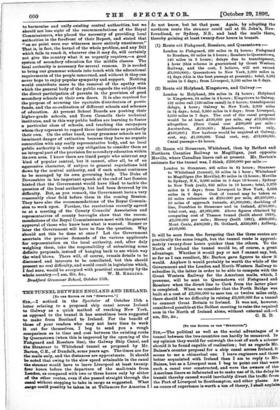THE TUNNEL BETWEEN ENGLAND AND IRELAND.
[To TER EDITOR Or THE " 8PZETATOR."] Sra,—I noticed in the Spectator of October 15th a letter relating to a proposed ship canal across Ireland to Galway as a quick method of reaching New York, as opposed to the tunnel it has sometimes been suggested to make from Scotland to Ireland. For the benefit of those of your readers who may not have time to work it out for themselves, I beg to send you a rough comparison as to time and cost between the existing route by Queenstown (when this is improved by the opening of the Fishguard and Rosslare line), the Galway Ship Canal, and the Stranraer to Whitehead tunnel as proposed by Mr. Barton, C.E., of Dundalk, some years ago. The times are for the mails only, and the distances are approximate. It should be noted that owing to the slow speed attainable in the canal the steamer would have to leave Liverpool at least twenty. four hours before the departure of the mail-train from London, as compared with two or three hours only by either of the other routes, even if she passed straight through the canal without stopping to take in cargo as suggested. What cargo could possibly be taken in at Tullamore for America I
do not know, but let that pass. Again, by adopting the northern route the steamer could call at St. John's, New- foundland, or Sydney, INS., and land the mails there, thereby gaining at least twenty-four hours in transit.
(1) Route vid Fishguard, Rosalare, and Queenstown
London to Fisbguard, 260 miles in 54 hours; Fishguard to Rosslare, 60 miles in 3 hours ; Rosslare to Queenstown, 140 miles in 3 hours ; delays due to transhipment, hour (this scheme is guaranteed by Great Western Railway, and the cost, I believe, will not exceed £3,000,000) ; Queenstown to New York, 2,900 miles in. 54 days (this is the best passage at present); total, 3,360 miles in 6 days ; from Liverpool, 3,100 miles in 6 days.
(2) Route via Holyhead, Kingstown, and Galway :- London to Holyhead, 264 miles in 54 hours ; Holyhead to Kingstown, 64 miles in 3 hours ; Kingstown to Galway, 132 miles rail (120 miles canal) in 3 hours; transhipment delays, hour; Galway to New York, 2,900 miles in 54 days ; total, 3,360 miles in 6 days ; from Liverpool, 3,050 miles in 7 days. The cost of the canal proposed would be at least £100,000 per mile, say £12,000,000, altogether. (Suez Canal cost £200,000 per mile ; Amsterdam, £150,000 ; Manchester, works only,. £160,000.) New harbour would be required at Galway,. cost, say, £1,000,000. Total cost, say, £13,000,000.. Canal passage-24 hours.
(3) Route rid Stranraer, Whitehead, then by Belfast and Northern Counties Railway to Magilligan, just opposite Moville, where Canadian liners call at present, Mr. Barton's estimate for the tunnel was, I think, £200,000 per mile :-
London to Stranraer, 405 miles in 84 hours ; Stranraer to Whitehead (tunnel), 35 miles in 1 hour ; Whitehead' to Magilligan (for Moville), 13(J miles in LI, hours ; Manilla. to Sydney, N.S., 2,000 miles in 3 days 10 hours ; Sydney to New York (rail), 850 miles in 18 hours ; total, 3,370• miles in 5 days ; from Liverpool to New York, 3,05( miles in 6 days. Cost of tunnel may be taken as 25 miles submarine at 2250,000 per mile, £6,250,000;. 10 miles of approach tunnels, ..E1,000,000.; doubling of line, Dumfries to Stranraer and in Ireland, £750,030 total cost, say, £8,000,000. Above figures obtained by comparing cost of Thames tunnel (built about 1830), £2,000,000 per mile ; Mersey (built 1881), £500,000; Mont Cenis, £400,000 ; St. Gothard, £250,000 ; Arlberg, £190,000.
It will be seen from the foregoing that the three routes are practically the same length, but the tunnel route is approxi- mately twenty-four hours quicker than the others. To the North of Ireland the tunnel would be, of course, a great advantage. Whether it would pay or not I cannot say, but, so far as I can recollect, Mr. Barton gave figures to show it would. Anyhow it would probably be worth the while of the Government and the London and North-Western Railway to subsidise it, the latter in order to be able to compete with the Great Western Railway for the American mails, which, I presume, will be sent to Queenstown via Fishguard and Rosslare when the direct line to Cork from the latter place is completed. When we consider that the Forth Bridge was built at a coat of £3,000,000 to save ten or twelve miles only,. there should be no difficulty in raising £8,000,000 for a tunnel to connect Great Britain to Ireland. It was not, however, considered possible at the Belfast meeting to raise the required sum in the North of Ireland alone, without external aid.—I






































 Previous page
Previous page